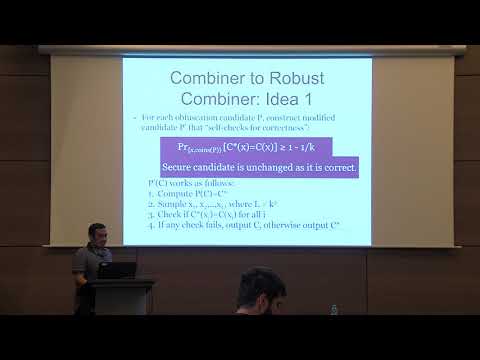Welcome to the resource topic for 2017/127
Title:
Robust Transforming Combiners from Indistinguishability Obfuscation to Functional Encryption
Authors: Prabhanjan Ananth, Aayush Jain, Amit Sahai
Abstract:Indistinguishability Obfuscation (iO) has enabled an incredible number of new and exciting applications. However, our understanding of how to actually build secure iO remains in its infancy. While many candidate constructions have been published, some have been broken, and it is unclear which of the remaining candidates are secure. This work deals with the following basic question: \emph{Can we hedge our bets when it comes to iO candidates?} In other words, if we have a collection of iO candidates, and we only know that at least one of them is secure, can we still make use of these candidates? This topic was recently studied by Ananth, Jain, Naor, Sahai, and Yogev [CRYPTO 2016], who showed how to construct a robust iO combiner: Specifically, they showed that given the situation above, we can construct a single iO scheme that is secure as long as (A) at least one candidate iO scheme is a subexponentially secure iO, and (B) either the subexponential DDH or LWE assumptions hold. In this work, we make three contributions: \begin{itemize} \item (\textbf{Better robust iO combiners.}) First, we work to improve the assumptions needed to obtain the same result as Ananth et al.: namely we show how to replace the DDH/LWE assumption with the assumption that subexponentially secure one-way functions exist. \item (\textbf{FE and NIKE from iO candidates and minimal assumptions.}) Second, we consider a broader question: what if we start with several iO candidates where only one works, but we don’t care about achieving iO itself, rather we want to achieve concrete applications of iO? In this case, we are able to work with the \emph{minimal} assumption of just polynomially secure one-way functions, and where the working iO candidate only achieves polynomial security. Under these circumstances, we show how to achieve both \emph{functional encryption} and \emph{non-interactive multiparty key exchance (NIKE)}. \item (\textbf{Correctness Amplification for iO from polynomial security and one-way functions.}) Finally, along the way, we obtain a result of independent interest: Recently, Bitansky and Vaikuntanathan [TCC 2016] showed how to amplify the correctness of an iO scheme, but they needed subexponential security for the iO scheme and also require subexponentially secure DDH or LWE. We show how to achieve the same correctness amplification result, but requiring only polynomial security from the iO scheme, and assuming only polynomially secure one-way functions. \end{itemize}
ePrint: https://eprint.iacr.org/2017/127
Talk: https://www.youtube.com/watch?v=rFzAydlz0j0
See all topics related to this paper.
Feel free to post resources that are related to this paper below.
Example resources include: implementations, explanation materials, talks, slides, links to previous discussions on other websites.
For more information, see the rules for Resource Topics .
